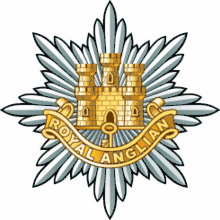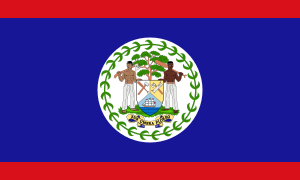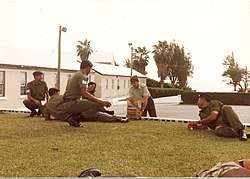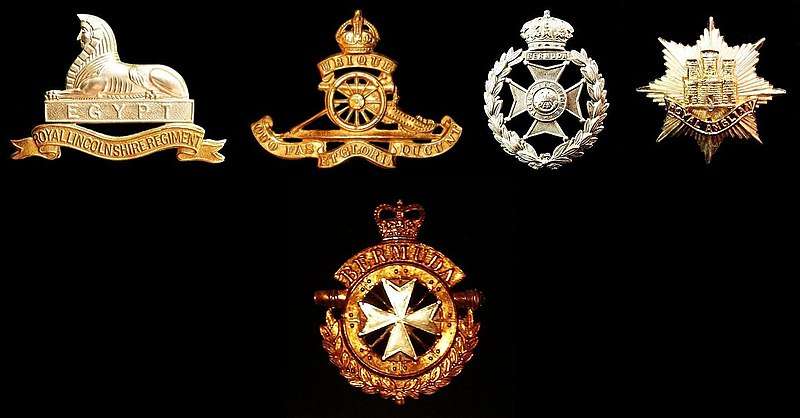Royal Anglian Regiment
The Royal Anglian Regiment (R ANGLIAN) is an infantry regiment of the British Army. It consists of two Regular battalions and one Reserve battalion. The modern regiment was formed in 1964, making it the oldest of the Line Regiments now operating in the British Army, and can trace its history back to 1685. The regiment was the first of the large infantry regiments and is one of the four regiments of the Queen's Division.
| The Royal Anglian Regiment | |
|---|---|
 | |
| Active | September 1964- |
| Allegiance | |
| Branch | |
| Type | Line infantry |
| Role | 1st Battalion - Light Infantry 2nd Battalion – Light Mechanised Infantry 3rd Battalion – Army Reserve |
| Size | Three battalions |
| Part of | Queen's Division |
| Garrison/HQ | Regimental Headquarters - Bury St Edmunds 1st Battalion – Woolwich 2nd Battalion – Cottesmore 3rd Battalion – Bury St Edmunds |
| Nickname(s) | The Vikings (1st Battalion) The Poachers (2nd Battalion) The Steelbacks (3rd Battalion) |
| Motto(s) | Stabilis |
| March | Quick - Rule Britannia/Speed the Plough Slow – The Northamptonshire |
| Anniversaries | 1 August - Minden Day 1 September – Regimental Formation Day |
| Commanders | |
| Colonel in Chief | The Duke of Gloucester, KG, GCVO |
| Colonel of the Regiment | Maj Gen Ralph Wooddisse CBE MC |
| Insignia | |
| Tactical Recognition Flashes | |
| Arm Badge | Salamanca Eagle From the Essex Regiment |
| Abbreviation | R ANGLIAN |
History
Formation
The regiment was formed on 1 September 1964 as the first of the new large infantry regiments, through the amalgamation of the four regiments of the East Anglian Brigade:[1]
- 1st (Norfolk and Suffolk) Battalion from the 1st Battalion of the 1st East Anglian Regiment (Royal Norfolk and Suffolk)
- 2nd (Duchess of Gloucester's Own Lincolnshire and Northamptonshire) Battalion – 1st Battalion, 2nd East Anglian Regiment (Duchess of Gloucester's Own Royal Lincolnshire and Northamptonshire)
- 3rd (16th/44th Foot) Battalion – 1st Battalion, 3rd East Anglian Regiment (16th/44th Foot)
- 4th (Leicestershire) Battalion – 1st Battalion, Royal Leicestershire Regiment.
The Royal Anglian Regiment was established to serve as the county regiment for the following counties:
Initially formed of seven battalions (four regular and three Territorial Army), the regiment was reduced in 1975 with the loss of the 4th (Leicestershire) Battalion to three regular battalions and three TA. The regiment was reduced again in 1992 to two regular and two TA battalions with the loss of the 3rd (16th/44th Foot) and 5th Battalions.[2]
Early operational history
Northern Ireland
The regiment carried out tours-of-duty throughout "the Troubles" in Northern Ireland and was present on 'Bloody Sunday' in Derry in 1972, when 14 unarmed civilians were killed.[3]
Yugoslav Wars
During the Yugoslav Wars, the 2nd Battalion was deployed to Bosnia in April 1994 as part of the United Nations peacekeeping force UNPROFOR.[4] During the tour, Corporal Andrew Rainey became one of the first ever non-officers to win the Military Cross, for his actions during a heavy contact between 3 Platoon, A Company and a Bosnian Serb Army unit on the confrontation line in the north of the Maglaj Finger.[5]
Croatia
In 1995 the 1st Battalion was sent to Croatia as part of 24 Airmobile Brigade between July and October of that year. The Vikings returned to the UK having suffered no casualties.[6]
Sierra Leone
Shortly after British forces intervened in Sierra Leone during its civil war, the 2nd Battalion briefly joined the IMATT force in June 2000 to help train the Sierra Leonean armed forces.[7]
Recent operational history
Afghanistan
In March 2002, 1st Battalion was sent to Afghanistan, where it was based in the capital Kabul as part of the International Security Assistance Force (ISAF). The following February, 2nd Battalion's A Company was posted to Kabul. They were replaced by C Company in June.[8]
In 2005, 1st Battalion undertook a tour in Iraq as part of Operation Telic 6 where the battle group was responsible for the Basra Rural South area of operations. C (Essex) Company was detached to act as a Brigade Operations Company and was involved in several high-profile arrest operations.[9]
The remaining Territorial battalion of the regiment, the East of England Regiment was re-designated on 1 April 2006 as the 3rd Battalion, Royal Anglian Regiment as part of the reforms.[2]
From March to September 2007, as part of 12th Mechanised Brigade, 1st Battalion was deployed to Afghanistan as part of Operation Herrick 6. This deployment was the subject of the Sky One documentary Ross Kemp in Afghanistan, broadcast in January/February 2008. A book has also been written by a former commanding officer about the battalion on this tour, Attack State Red, published by Penguin. They were stationed in Helmand Province. The fighting attracted much media attention due to the ferocity of the combat, with soldiers often having to resort to using bayonets. The battalion suffered nine casualties during its tour, five from attacks and four accidental.[10][11]
In a reported friendly fire incident, on 23 August 2007, one of a pair United States Air Force F-15E fighter aircraft called in to support a patrol of the 1st Battalion in Afghanistan dropped a bomb on the same patrol, killing three men, and severely injured two others. It was later revealed that the British forward air controller who called in the strike had not been issued a noise-cancelling headset, and in the confusion and stress of the battle incorrectly confirmed one wrong digit of the co-ordinates mistakenly repeated by the pilot, and the bomb landed on the British position 1,000 metres away from the enemy. The coroner at the soldiers' inquest stated that the incident was due to "flawed application of procedures" rather than individual errors or "recklessness".[12]
Elements of 3rd Battalion deployed to Afghanistan as part of 11 Light Brigade in October 2009 as part of Operation Herrick 11.[13] Soldiers from 1st Battalion also saw action guarding checkpoints in the Nad-e-Ali area, in central Helmand province later in the year.[14]
1st Battalion and elements of 3rd Battalion also deployed to Afghanistan as part of 12th Mechanised Brigade in March 2012 as part of Operation Herrick 16 in the closing stages of the conflict.[15]
Iraq
In Spring 2006, 2nd Battalion deployed to Iraq as part of Op Telic 8 and formed Basra City South Battlegroup. C (Northamptonshire) company was detached to operate as part of Force Reserve and was involved in many high-profile arrest and strike operations. During the tour the regiment mourned the loss of two soldiers; on 13 May 2006 Privates Joseva Lewaicei and Adam Morris died as a result of injuries sustained from a roadside bomb attack in Basra. A third soldier was badly injured.[16]
In Autumn 2017 the 2nd Battalion Royal Anglian Regiment deployed to Cyprus.[17] It returned to Kendrew Barracks in August 2019.[18]
Recent history
On 9 October 2019, 100 men from C and D companies marched through Haverhill and received the freedom of the town. The battalion was led by their commanding officer Lieutenant Colonel Phillip Moxey MBE.[19] In 2020 during the 2019–20 coronavirus pandemic, members of the regiment helped assist the NHS for testing of COVID-19 patients, and provided checkpoints throughout London in collaboration with the Grenadier Guards.[20]
Regimental museum
The Royal Anglian Regiment Museum is based at Duxford in Cambridgeshire.[21]
Regimental ethos
The regimental ethos is as follows:[22]
We are a county based Regiment bound together by a closely-knit family spirit. Our approach is classless, based on mutual respect and trust, where developing and believing in our soldiers is paramount. We are a forward looking, self-starting and welcoming team for whom the mission remains key.
Structure
In 1995, each battalion renamed its companies in order to perpetuate its lineage from the old county regiments.[23] The current structure is as follows:
1st Battalion, The Royal Anglian Regiment 'The Vikings'
- A (Royal Norfolk) Company
- B (Suffolk) Company
- C (Essex) Company
- D (Cambridgeshire) Company
The 1st Battalion operates in the light infantry role under 7th Infantry Brigade and is based at Woolwich.[24]
2nd Battalion, The Royal Anglian Regiment 'The Poachers'
- A (Royal Lincolnshire) Company
- B (Royal Leicestershire) Company
- C (Northamptonshire) Company
- D (Bedfordshire and Hertfordshire) Company
- HQ (Rutland) Company[25]
The 2nd Battalion operates in the light infantry role and is currently based at Kendrew Barracks.[18]
3rd Battalion, The Royal Anglian Regiment 'The Steelbacks'
- 1 (Norfolk) Company
- 2 (Leicestershire & Northamptonshire) Company
- 3 (Essex) Company
- 4 (Lincolnshire) Company
- HQ (Suffolk & Cambridgeshire) Company
The 3rd Battalion operates in the light infantry role under 7th Infantry Brigade and Headquarters East and is based at Bury St Edmunds.[26]
Both the 1st Battalion and 2nd Battalion rotate as resident units in British Forces Cyprus.[27]
Battalion nicknames
The battalion nicknames are as follows:
The Vikings – 1st Battalion
The nickname stems from the late 1960s when the Commanding Officer of the 1st Battalion, The 1st East Anglian Regiment Lt Col A F Campbell, MC said it described the Nordic influence on the counties of Norfolk and Suffolk. The nickname stuck, was adopted by the 1st Battalion on formation, and is still widely used today.[28]
The Poachers – 2nd Battalion
This stems from the Regimental March, The Lincolnshire Poacher, of one of their predecessors, the Royal Lincolnshire Regiment.[29]
The Steelbacks – 3rd Battalion
This was the nickname of the 58th Regiment of Foot, later the 2nd Battalion the Northamptonshire Regiment. It stems from Private Hovenden of the 58th being described as a 'Steelback' after a flogging in 1813.[30]
Traditions

Marches
The regimental marches are as follows:[31]
- Regimental quick march: Rule Britannia and Speed the Plough
- Regimental slow march: The Northamptonshire
Regimental days
The regimental days are as follows:[31]
The Regiment
- 1 September – The Royal Anglian Regiment Formation Day
The 1st Battalion
- 1 August – Minden Day
The 2nd Battalion
- 27 July – Talavera Day
Celebrated by the individual battalions (in date order)
- 2nd Battalion: 10 February – Sobraon Day
- 1st Battalion: 17 March – St Patrick's Day
- 1st Battalion: 25 April – Almanza Day
- 2nd Battalion: 25 June – Hindoostan Day
- 1st Battalion: 27 June – Dettingen Day
- 1st Battalion: 22 July – Salamanca Day
- 2nd Battalion: 27 July – Talavera Day
- 1st Battalion: 1 August – Minden Day
- 2nd Battalion: 13 August – Blenheim Day
Uniform
Uniforms are as follows:[31]
The Cap badge: The Cap badge consists of a silver star of eight points, upon which is the castle of Gibraltar with a scroll inscribed 'ROYAL ANGLIAN' in gold. The Suffolks, Essex and Northamptonshire Regiments served at the Great Siege of Gibraltar from 1779 to 1783.[32]
Beret: The 1st Battalion the Royal Norfolk Regiment joined 24th Guards Independent Brigade Group in 1942; the Guards Officers wore a khaki beret and the Norfolks adopted it at the time. The beret went out of use after the war but was re-adopted in 1960, and has continued in use. It was adopted by the rest of the Royal Anglian Regiment in 1970 and the wearing of it extended to Warrant Officers. The Regiment complete went to khaki berets in 1976.[32]
The Black Patch:The black patch behind the cap badge commemorates the burial of Sir John Moore at Corunna in 1809 by officers and men of the 9th of Foot, the rearguard of the withdrawing British Expeditionary Force.[32]
Tactical Recognition Flashes (TRFs): The 1st Battalion wear the red and yellow Minden Flash. It originates from the Suffolk Regiment who adopted it after Dunkirk; it symbolises the red and yellow of the roses at the Battle of Minden. The 2nd Battalion wear the black, yellow, black of the Bedfordshire and Hertfordshire Regiment. The 3rd Battalion wear the Regimental colours, blue, red and yellow.
Eagle: The Salamanca Eagle is worn on the left sleeve on No. 1 and No 2 dress tunics. It is a replica of the French 62nd Regiment's Eagle which was captured by the 2/44th (East Essex) Regiment of Foot at the Battle of Salamanca during the Peninsular War. The British Army captured a total of six of Napoleon's Eagles, four of which were taken with bayonet. The original Eagle is still held in the Essex Regiment Museum and is displayed in the 1st Battalion on Salamanca Day.[32]
Collar Badges: The 1st Battalion wear a figure of Britannia superimposed on a Castle and Key. Britannia was awarded to the Royal Norfolk Regiment for service at the Battle of Almansa and the castle was the cap badge of the Suffolk Regiment, commemorating the siege of Gibraltar. The 2nd Battalion wear the Sphinx with underneath a scroll inscribed 'TALAVERA'. The Sphinx is from the Royal Lincolnshire Regiments for service in Egypt, 'TALAVERA' is from the Northamptons' famous victory at that battle. The 3rd Battalion wear the cap badge as their collar badge.
Lanyards: The lanyard of the 1st Battalion is yellow from the Royal Norfolk Regiment. The 2nd Battalion wear black to commemorate the Northamptonshire Regiment. The 3rd Battalion wears the black and primrose lanyard of the former Bedfordshire and Hertfordshire Regiment.
Buttons: All ranks wear the Royal Leicestershire Regiment buttons, a tiger surrounded by an unbroken laurel wreath. The Tiger is in memory of the Regiments distinguished campaign service in India, the wreath commemorates the Battle of Princeton in the American War of Independence.[32]
Band
The first trace of a band within the Northamptonshire Regiment was recorded in 1798, during which a "German bandmaster was engaged". Military bands have continued in this regiment over the years after Territorial Army battalions of the former regiments were affiliated were merged. In 1986, the first women were recruited into the band from the Women's Royal Army Corps. In 1996, the 5th Battalion of the Royal Anglian Regiment was reorganized with the regimental Council electing to keep the band, under the name of the Band of the Royal Anglian regiment following the amalgamation of the Regular Royal Anglian bands into the Bands of the Queen's Division.[33]
Order of precedence
| Preceded by Royal Regiment of Fusiliers |
Infantry Order of Precedence | Succeeded by Yorkshire Regiment |
Lineage
| 1880[34] | 1881 Childers Reforms[34] | 1921 Name changes | 1957 Defence White Paper | 1966 Defence White Paper | 1990 Options for Change | 2003 Delivering Security in a Changing World |
|---|---|---|---|---|---|---|
| 9th (East Norfolk) Regiment of Foot | The Norfolk Regiment renamed in 1935: The Royal Norfolk Regiment |
1st East Anglian Regiment (Royal Norfolk and Suffolk) | The Royal Anglian Regiment | |||
| 12th (East Suffolk) Regiment of Foot | The Suffolk Regiment | |||||
| 10th (North Lincoln) Regiment of Foot | The Lincolnshire Regiment renamed in 1946: The Royal Lincolnshire Regiment |
2nd East Anglian Regiment (Duchess of Gloucester's Own Royal Lincolnshire and Northamptonshire) | ||||
| 48th (Northamptonshire) Regiment of Foot | The Northamptonshire Regiment | |||||
| 58th (Rutlandshire) Regiment of Foot | ||||||
| 16th (Bedfordshire) Regiment of Foot | The Bedfordshire Regiment renamed in 1919: The Bedfordshire and Hertfordshire Regiment |
3rd East Anglian Regiment (16th/44th Foot) | ||||
| 44th (East Essex) Regiment of Foot | The Essex Regiment | |||||
| 56th (West Essex) Regiment of Foot | ||||||
| 17th (Leicestershire) Regiment of Foot | The Leicestershire Regiment renamed in 1946: The Royal Leicestershire Regiment | |||||
Alliances
The regiment's alliances are as follows:
.svg.png)
.svg.png)
.svg.png)
.svg.png)
.svg.png)










The Royal Bermuda Regiment


The Royal Anglian Regiment has a unique relationship with the Royal Bermuda Regiment (RBR), a Territorial battalion of the British Overseas Territory of Bermuda. Although the Royal Bermuda Regiment is usually described as an affiliated regiment, its relationship to the Regiment is more akin to that of one of Royal Anglian's own TA battalions. The Royal Bermuda Regiment is an amalgamation of the old Bermuda Militia Artillery and Bermuda Volunteer Rifle Corps (BVRC, which had been renamed the Bermuda Rifles). The 2nd Battalion of the Lincolnshire Regiment, one of Royal Anglian Regiment's predecessors, was serving in the Bermuda Garrison when the First World War began in 1914 and its Commanding Officer, Lieutenant-Colonel George Bunbury McAndrew, found himself acting Governor and Commander-In-Chief of Bermuda, in the absence of the Governor Lieutenant-General Sir George Bullock, and oversaw the colony's placement onto a war footing. The battalion left Bermuda for France in October, 1914. The BVRC formed an overseas contingent, composed of Captain Richard Tucker and 88 other ranks, in December, which was intended to join the 2nd Battalion of the Lincolnshire Regiment on the Western Front, but which was instead attached to the 1 Battalion of the Lincolnshire Regiment in June, 1915, as it had greater need for reinforcements. A second BVRC contingent, of one officer and 36 other ranks, arrived from Bermuda the following year and merged with the dozen survivors of the first contingent. The BVRC contingent served with 1 Lincolns in France, Belgium and Ireland until 1919. The affiliation of the Lincolns and the BVRC was made official after the War, with the Lincolns adopting the same role it fulfilled to its own TA battalions: providing seconded Permanent Staff Instructors and officers. The BVRC sent two more drafts to the Lincolns during the Second World War (in 1940 and 1944). When the BVRC was amalgamated into the Bermuda Regiment in 1965 (the Royal Bermuda Regiment from 2015), the Royal Anglian Regiment, as successor to the Royal Lincolns, continued the paternal relationship. In addition to providing a PSI to each of the Royal Bermuda Regiment's rifle companies, many other Royal Anglian Regiment personnel have been seconded or loaned to the Royal Bermuda Regiment over the years. The staff officer is normally seconded from the Royal Anglians. The Bermuda Regiment's first nine adjutants (from 1965 to 1984) were all Royal Anglian officers. Three of its past regimental sergeant majors were seconded from the Royal Anglian Regiment. In 1992, the Royal Bermuda Regiment had two serving lieutenant-colonels, as its staff officer, a Royal Anglian major, was promoted to the same rank as its commanding officer (CO). In 1996, the Royal Bermuda Regiment's second-in-command, staff officer, and adjutant were all on secondment from the Royal Anglians. Additionally, senior NCOs are loaned to the Royal Bermuda Regiment for the duration of its annual recruit camps, with one attached to each platoon of its training company.[35]
Popular culture
In 1989, the Band and fifty members of the old 3rd Battalion were featured in the opening and closing sequences of BBC historical sitcom Blackadder Goes Forth with the band, men and actors Rowan Atkinson, Hugh Laurie, Stephen Fry, Tony Robinson and Tim McInnerny dressed in World War I period uniforms marching to "The British Grenadiers" and the Blackadder theme song. It was shot on location at the former Colchester Cavalry Barracks.[36]
References
- Swinson, Arthur (1972). A Register of the Regiments and Corps of the British Army. London: The Archive Press. p. 270. ISBN 0-85591-000-3.
- "The Bedfordshire Regiment in the Great War". Bedford Regiment. Retrieved 26 April 2014.
- "The Saville Inquiry 2003". BBC. 11 June 2010. Retrieved 26 April 2014.
- "Operation Grapple". Parliamentary Debates (Hansard). House of Commons. 10 February 1994.
- Dunstan, Simon (1 March 2000). "Rainey and 'Reggie': A Poacher's MC in Bosnia". Osprey Publishing. Archived from the original on March 13, 2012. Retrieved 26 April 2014.CS1 maint: unfit url (link)
- "British units deployed to Bosnia". Britain's small wars. Archived from the original on 20 April 2014. Retrieved 26 April 2014.
- "UK Forces Deployed in Sierra Leone". Britain's small wars. Retrieved 26 April 2014.
- "Operation Veritas: British Units Deployed". Britain's small wars. Retrieved 26 April 2014.
- "We're at the top of the Basra hit list". Northampton Chronicle. 3 August 2006. Retrieved 26 April 2014.
- "British military fatalities in Afghanistan". BBC. Retrieved 26 April 2014.
- "UK military fatalities in Afghanistan". Parliamentary Debates (Hansard). House of Commons. 30 October 2007. col. 189–190.
- "'Flawed' actions led to fatal 'friendly fire' bombing". BBC. 26 April 2010. Retrieved 2011-02-15.
- "Afghanistan". Parliamentary Debates (Hansard). House of Commons. 15 July 2009. col. 79–82.
- Esther Addley. "Bury St Edmunds funeral for 100th British soldier killed in Afghanistan". the Guardian. Retrieved 6 February 2015.
- "Op Herrick 16 – 12 Mechanised Brigade". Defence Viewpoints. Retrieved 19 May 2018.
- "Dead British soldiers are named". BBC. 15 May 2006. Retrieved 26 April 2014.
- "Poachers gear up for rapid deployment force role in Middle East and North Africa". Leicester Mercury. 9 July 2017. Retrieved 19 October 2017.
- "Goodbye Cyprus: Surprise Send-Off For The Poachers' Commanding Officer". 16 July 2019. Retrieved 7 October 2019.
- "Vikings exercise the Freedom of Haverhill". www.army.mod.uk. Retrieved 2019-10-16.
- "Royal Anglian Regiment and Grenadier Guards boosts staff in London". Instagram. Retrieved 2020-04-14.
- Collett, Amy (14 September 2010). "Royal Anglian memorial unveiled: we will never forget their sacrifices". PeterboroughToday.co.uk. Johnston Publishing Limited. Retrieved 28 September 2010.
- Bowns, Steven (2014). Aden to Afghanistan. Oxford: Osprey. p. 21. ISBN 978 1 4728 0805 9.
- "Royal Anglian Regiment". British Army units 1945 on. Retrieved 26 April 2014.
- "Royal Anglian's and their children honoured at medal parade". ITV. 14 October 2015. Retrieved 26 November 2016.
- "2nd Battalion The Royal Anglian Regiment". army.mod.uk. Royal Anglian Regiment. 6 December 2019. Retrieved 6 December 2019.
HQ “Rutland” Company
- "Territorial Army faces new challenge as regulars are cut". BBC. 11 September 2013. Retrieved 30 April 2016.
- "Transforming the British Army: An Update" (PDF). Ministry of Defence. p. 7. Retrieved 30 April 2016.
- "History of the 1st Battalion, Royal Anglian Regiment". Viking Veterans. Retrieved 6 July 2018.
- "The Royal Anglian and Royal Lincolnshire Regimental Association". thelincolnshireregiment.org. Retrieved 11 December 2014.
- Stallard CG (1992). 5th Battalion Royal Anglian Regiment (The Steelbacks). Alexander-Davis Associates.
- Pamphlet distributed to all soldiers who joined the Regiment in 2018
- The Royal Anglian Regiment : A Soldiers Guide, 2018
- "The Band of the Royal Anglian Regiment | The British Army". Army.mod.uk. 1964-09-01. Retrieved 2020-04-11.
- The London Gazette, Page 3300-3301 (1 July 1881). "Childers Reform" (24992). Government of the United Kingdom. Retrieved 27 October 2016.
- "Royal Anglian soldiers boost Bermuda Regiment". Ministry of Defence. 19 January 2011. Retrieved 26 April 2014.
- "Blackadder Goes Forth". IMDB. Retrieved 26 April 2014.
External links
| Wikimedia Commons has media related to Royal Anglian Regiment. |